Masterpieces of Mexico: The Most Renowned Paintings Through Time
- A Brief Overview of Mexican Art and History
- Mexican Artists of the Late Colonial Era
- The 10 Most Famous Mexican Paintings
- Virgin of Guadalupe and the Four Apparitions by Nicolas Enriquez (1773)
- St. Charles Borromeo Handing Alms to People by Jose Salome Pina (1853)
- Prometheus by Jose Clemente Orozco (1930)
- Caballista del Circo by Maria Izquierdo (1932)
- El Hombre en La Encrucijada by Diego Rivera (1934)
- Echo of a Scream by David Alfaro Siqueiros (1937)
- Autorretrato con Collar de Espinas by Frida Kahlo (1940)
- The Magical World of the Maya by Leonora Carrington
- Dualidad by Rufino Tamayo (1964)
- Untitled by Manuel Felguerez (2015)
- Conclusion
- FAQs
- What is the Most Expensive Mexican Painting?
- What are the Most Popular Mexican Painters?
- What are the Main Art Movements in the History of Mexican Art?
Since its pre-colonial period, Mexican culture has produced some of the best paintings and sculptures. This includes art from Mesoamerica. This article provides a quick overview of Mexican Art and highlights some of the most popular Mexican paintings that have caught the attention of global artists.
A Brief Overview of Mexican Art and History
Most people tend to concentrate on the great masters and artworks from Europe without taking into account other areas of talent around the globe. Mexican art is usually reduced to artworks created during pre-colonial times and is one area of study that is underappreciated. Like many other areas, Mexico was subjected to colonial division and interruption. The most notable events were the Spanish Conquest, the Mexican War of Independence, and the Mexican Revolution.
In Mexico, the 19th century saw the art form develop the nation's identity.
Mesoamerican Art flourished in what is now southern and central Mexico. Before the Spanish conquest, the majority of Mexican art was heavily influenced by indigenous cultures and religion. The distinction between art and culture was blurred.
The art produced during the 300 years of Spanish rule was mainly devoted to decorating churches, including casta paintings, historical paintings, and portraits from the 18th century. During this period, the Academy of San Carlos was the main training institution for
Mexican Artists of the Late Colonial Era
Mexican art of this period did not exclusively consist of European subjects and approaches to balance among indigenous cultural art and European styles.
Mexico's struggle to achieve independence from Spain in 1810, which lasted until 1821, caused immense political turmoil. As is often believed, the event was not a single, unified conflict but a mix of local conflicts, which can be interpreted as a civil war or revolution. The outcome of independence wasn't guaranteed, but the Spanish faced their threats with the invasion of Napoleon Bonaparte in 1808 and the subsequent abdication of Charles V.
Mexico experienced numerous religious and cultural separations, as well as the Spanish Constitution being implemented in 1812. The new document was intended to provide a framework for a new government in the wake of the removal of the monarchy. It also sought to accommodate the needs of criollos, or Americans born Spanish, and to reconcile the people of Mexico with the Peninsulares.
The American-born Spanish group supported the rebellion for independence against Spanish rule. One of the critical moments in this period was the Cry of Dolores, issued in 1810 by a Parish Priest named Miguel Hidalgo y Costilla.
The revolt began with this event and lasted many years. It spread to the Gulf Coast and northern Mexico City. Ferdinand VII, who had taken control after Napoleon's defeat and tried to restore a monarchy, was overthrown in 1820 by the Spanish liberals.
The conflict ended in 1821 when the Cordoba Treaty brought an end to the royal government. During Isabella II's reign, Mexico gained independence from Spain in 1836 following many Spanish attempts to regain control.
The 10 Most Famous Mexican Paintings
The Mexican Muralist Movement is one of Mexico's most important art movements. Famous artists like Fernando Leal and Diego Rivera led it. They were commissioned to create artworks that told a story about Mexican culture and history.
We will examine a few Mexican paintings and the visual stories they tell.
Virgin of Guadalupe and the Four Apparitions by Nicolas Enriquez (1773)
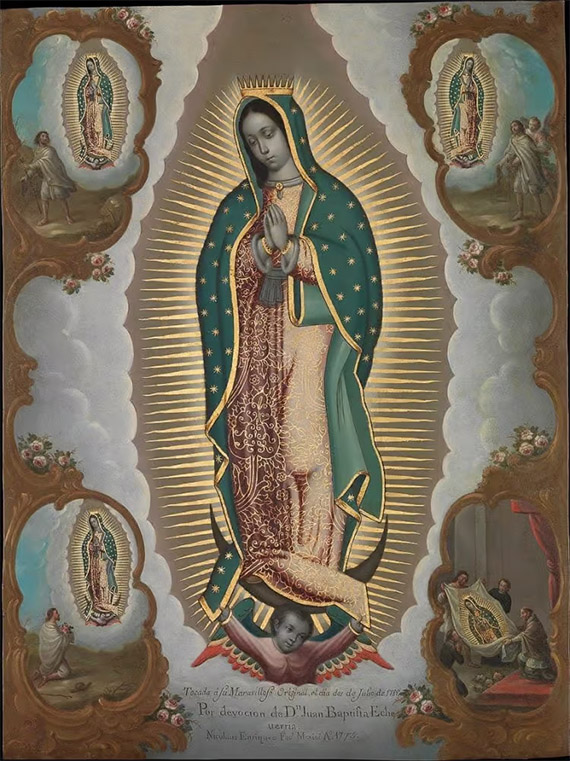
Nicolas Enriquez, a painter from the Novohispanic period and a student of Juan Rodriguez Juarez (a famous Spanish painter), was one of the most important painters of his time. Enriquez painted this highly revered and iconic painting of the Virgin Mary of Guadalupe in 1773. It has become one of New Spain's most famous images.
This painting, called Acheiropoieta, was said to be an exact copy of the original, which depicted the Virgin ascending Mount Tepeyac in 1531. The Virgin's image is surrounded by images that record her appearance at Tepeyac, near Mexico City, to an Indian, Juan Diego, who had recently converted to Christianity. According to the story, the Virgin told Diego to inform the bishop of her need for a temple.
The Virgin of Guadalupe, or the Virgin of Guadalupe, is a symbol of Catholicism that spread throughout Mexico and its importance to the Nahuatl people of Mexico, an indigenous group, and the Spanish.
Virgin of Guadalupe With the Four Apparitions by Nicolas Enriquez is currently located at the Metropolitan Museum of Art, New York.
St. Charles Borromeo Handing Alms to People by Jose Salome Pina (1853)

Jose Salome Pina is a Mexican painter from the 19th century who was often associated with Nazarenes. Pina painted this famous work with the intent of hanging it in the San Carlos Academy's meeting room.
The painting depicts the patron saint giving clothing to the poor people gathered in front of him.
Priests can be seen to the patron's left holding a basket and a crosier. The Gothic church in the background looks like the Cathedral of Milan. It also highlights the relationship between Saint Charles and the institution. Pina received a scholarship to study in Rome after this painting was so well received by the institution.
St. Charles Borromeo Handing Alms to People by Jose Salome Pina is currently housed by the Museo Nacional de Arte (Museum of National Arte).
Prometheus by Jose Clemente Orozco (1930)
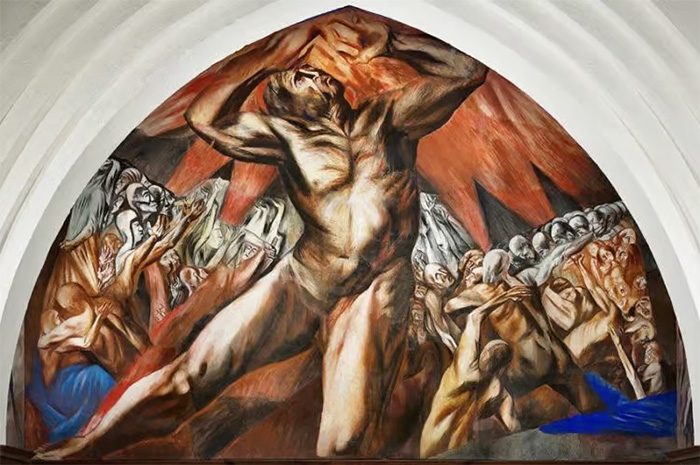
Jose Clemente Orozco, a Mexican caricaturist who painted large murals with a political theme, was one of the most important contributors to the Mexican Mural Renaissance. Orozco, fascinated by machines and the theme of human suffering and inspired by them, was heavily influenced and devoted to the political causes of the local people and those often unrepresented.
Orozco’s famous Prometheus mural was commissioned to be displayed at the Men's Dining Hall in the Neo-Gothic style in Pomona. It depicts scenes and figures from ancient Greek mythology about the Titan Prometheus.
Prometheus by Jose Clemente Orozco is on display in the Frary Dining Hall at Pomona College, California.
Prometheus is shown reaching for a fire meant to be a gift from Zeus for humans but instead becomes the cause of Zeus' punishment. Prometheus appears surrounded by people who have mixed reactions towards the gift.
Art historians say that the painting serves as a metaphor to illustrate the difficulty of gaining and expanding knowledge when conservative authorities are present.
The fresco's mixed reactions suggest that human development is a dual process that brings advantages and struggles.
It is clear that the mural has a special meaning for Orozco, as the suggested meaning may allude to his personal struggles with parties who did not share his political views.
Caballista del Circo by Maria Izquierdo (1932)
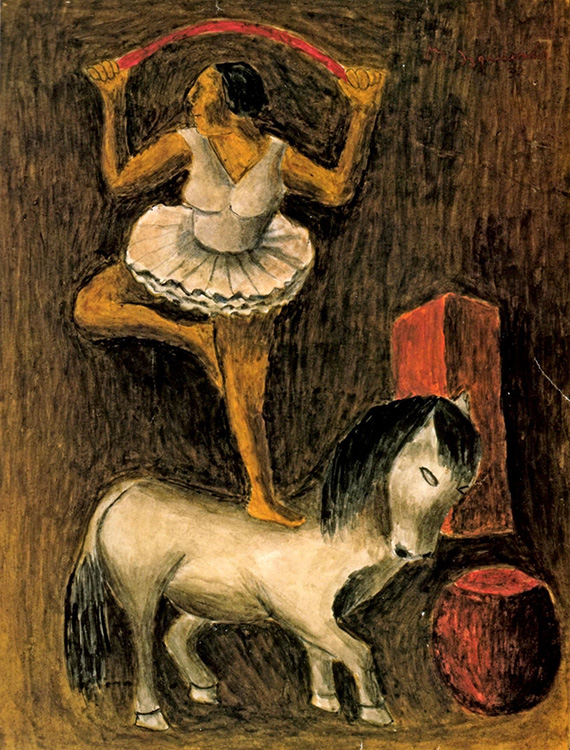
Maria Izquierdo was one of the very first Mexican women artists to exhibit in the United States. Her famous painting is known as Amazona Blanca, which means "White Horsewoman" (in English). This painting is sometimes called Circus Rider.
The painting depicts a woman on a horse seated with confidence. It is a symbol of courage.
The woman in the painting is a female circus performer. Izquierdo, fond of circuses since childhood, used the performer's image as an alter-ego. The painting challenged the Mexican tradition of portraying male figures, heroes, and heroines after the Mexican Revolution.
El Hombre en La Encrucijada by Diego Rivera (1934)
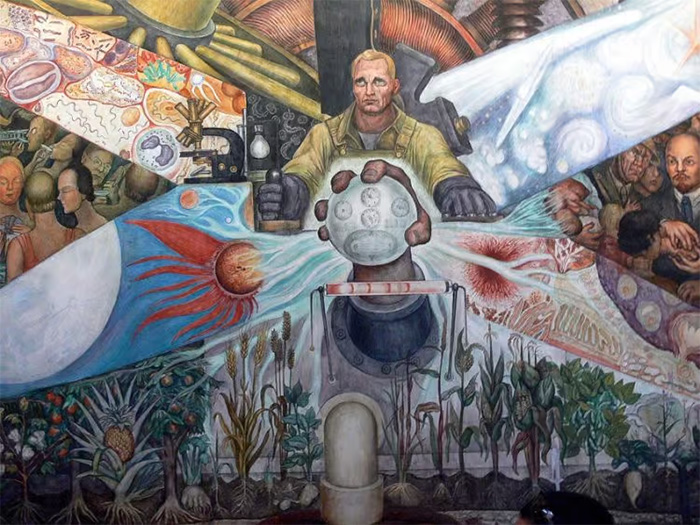
Diego Rivera is a Mexican muralist who was a famous artist in Mexico. His works are national monuments. This painting, from 1934, is one of his most famous Mexican paintings. A Man at the Crossroads, or as it's known in English, "Man at the Crossroads", is a massive mural that illustrates the various aspects of Mexican social and scientific culture. Rivera was also one of Mexico City's most famous artists.
The Rockefeller family, the controversy surrounding the painting, and its destruction made it famous.
The original painting does not hang in Rockefeller Plaza, New York City. It is a replica. According to history, Rivera installed it as a triptych. The middle panel depicted a worker controlling machinery. It was accompanied by the two other panels representing Capitalism and Socialism.
The Rockefeller Plaza initially approved the idea of the painting, which depicted the differences between Capitalism & Communism. However, after the painting caught the attention of the New York World-Telegram, Rivera added images of a Soviet May Day Parade and Vladimir Lenin. Rivera's new additions weren't well received by the Rockefeller Center Director, who instructed him to remove them.
The Mexican artist community was in a tizzy when Rivera refused to move, and his original fresco had to be destroyed before it could even be completed.
Josep Maria Sert began a new mural in 1934 after the original painting was removed. Rivera recreated the work in a new title: Man, Controller Of The Universe, as there is no documentation of the original. Cradle Will Rock, a 1999 film, and Frida, a 2002 film, tell the story of the painting as well as the conflicts that resulted from it.
Echo of a Scream by David Alfaro Siqueiros (1937)

Echo of a Scream, painted in 1937, reflects the influence of Surrealism and the historical wars on Mexican painting. David Alfaro Siqueiros was one of Mexico's artists, known for his social realist works and public murals.
Siqueiros also belonged to the Mexican Communist Party and was a staunch Stalinist.
This famous Mexican artwork shows a crying child or infant in a bleak, unsettling landscape. It echoes war's trauma and the effect of human loss on children. Mexico's independence was celebrated, but many people forget the tragedy that followed the Spanish conquest.
Autorretrato con Collar de Espinas by Frida Kahlo (1940)

Frida Kahlo, a Mexican artist revered for her Magical Realist style and pioneering explorations of Mexican culture, identity, race, and class, has been described as one of the greatest Mexican artists in history. Her chronic pain and interest deeply influenced Kahlo in Mexican pop culture.
Kahlo’s style of painting and art is linked to the post-Mexican revolution movement known as the Mexicayotl, which centered around defining Mexican identity.
This famous Mexican painting from 1940, Self-Portrait With Thorn Necklace And Hummingbird, shows Kahlo using Mexican culture to define her artistic aesthetic. It also features powerful iconographic images rooted in Mexican tradition.
Mexican folklore says that the image of a dead hummingbird hanging from her neck was a charm to bring her luck when it came to falling in love. The hummingbird pendant can also be interpreted as a symbol of Huitzilopochtli, the Aztec god of war.
Kahlo included a black cat behind her left shoulder as a contrast to the charm of good fortune. The panther was a sign of death and bad luck. The spider monkey refers to Diego Rivera, who gave her the monkey as a gift. The monkey can be seen pulling on Kahlo's thorny pendant, which could represent the crown of thorns that Jesus Christ wore.
This may allude to Kahlo's view that she was a Christian martyr and had suffered bad luck because of an unsuccessful romance. Its background is a sign of fertility and contrasts sharply with the death symbols in the foreground.
Frida Kahlo is also known as a strong supporter of the Mexican Revolution. She even attempted to change the date on her birth certificate to coincide with the start of the Revolution.
During the Revolution, the "cult" of Mexican femininity was very popular. It was seen as a way to sacrifice oneself and achieve martyrdom. Kahlo rejected the limited view of femininity and adopted an identity as a Tehuana. She chose this identity because the Tehuana culture was equal to their Zapotec counterparts, represented strength, exoticism, and sensuality, and displayed equality. As an artist, Kahlo can evoke the complexity of Mexican symbolism.
The Magical World of the Maya by Leonora Carrington

Artist Mary Leonora Carrington (born 1917 - 2011)
The Magical World of the Maya, a painting by British-born Mexican artist Leonora Cairny, is considered one of the most iconic Mexican works of art that provides an artistic interpretation of the Mayan culture of the 1960s.
Carrington used historical references and Mayan codices to reimagine the ancient world's culture.
She not only worked with anthropologists to create her Mayan-inspired work but also included her own poetics. Carrington includes some cosmic representations of God, such as the rainbow at the center of her mural and the personified Chac.
Dualidad by Rufino Tamayo (1964)
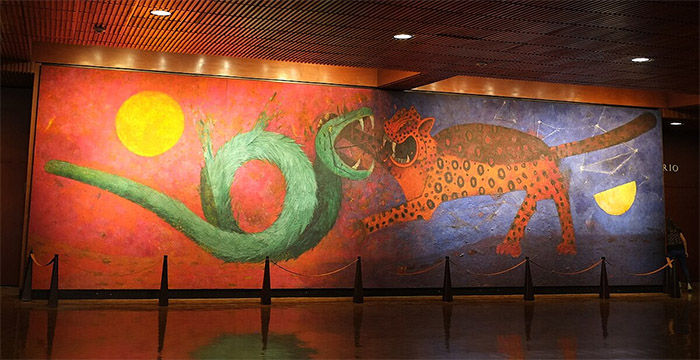
Artist Rufino Arellanes Tamayo (1999 - 1991). Date 1964. Medium Mural Dimensions. (cm). Dimensions Not Available. Where it is Housed National Museum of Anthropology. Mexico City.
Rufino Tamayo is one of Mexico’s most popular painters. He was commissioned to create this large mural by the National Museum of Anthropology, Mexico City, to give a modern view of pre-Hispanic Mexican nationalism.
This mural combines pre-Hispanic thought as represented by cosmogonic myths of the Nahua. It includes images of the jaguar, serpent, and Quetzalcoatl, representing Tezcatlipoca and Quetzalcoatl's conflict.
The mural depicts the two sons of Ometecuhtli. The gods appear to be fighting, symbolizing the flow of universal energies that form the cosmic age and consist of "the creation" (of the earth, the living and celestial body). This scene references the dual nature of the iconographic representation. It can be understood as the duality between night and day, represented by the fight between the snake and the jaguar.
Untitled by Manuel Felguerez (2015)

Artist Manuel Felguerez (28 - 2010)
Manuel Felguerez's Abstract painting, "Untitled", is one of the most famous paintings of the 21st Century. It was created by balancing chaos and order. Untitled (2015) shows us how the artist combines materiality, abstraction, and geometry to create a structure that helps him understand chaos and order in the multidimensional world. Manuel Felguerez, a Mexican artist who was a pioneer during the 1950s, was a member of a group that rejected the Mexican School's approach to painting through Muralism.
This was the era when Octavio Paz coined the Rupture Movement in response to a generational shift. The movement was aimed at pushing ideals that allowed for more aesthetic freedom.
Conclusion
The top ten Mexican artworks represent only a small part of Mexico's culture, heritage, and history. Paintings have played a significant role in the history of Mexican Art.
They have become a way to express the impact of the tumultuous conflicts that have affected many indigenous groups. Some noteworthy examples of famous art in Mexico include "Omnisciencia" (1925) by Jose Clemente Orozco, "The History of Mexico" (1929-1935) by Diego Rivera, and "La marcha de la humanidad en la Tierra y hacia el cosmos" (1964-1971) by David Siqueiros.
FAQs
What is the Most Expensive Mexican Painting?
Frida Kahlo's 1949 self-portrait, Diego and I, was the most expensive Mexican painting. It sold for $ 34.9 million.
What are the Most Popular Mexican Painters?
Mexican artists include Diego Rivera and Frida Káhlo. Also, Jose Clemente Orozco. David Siqueiros. Rufino Tamayo. Maria Izquierdo.
What are the Main Art Movements in the History of Mexican Art?
Mexican art history is characterized by several major movements, including Magic Realism or the so-called Mexican Muralism, Abstract Expressionism, Surrealism (aka Social Realism), the Rupture Movement, and Neomexicanismo.
No Comments Yet...